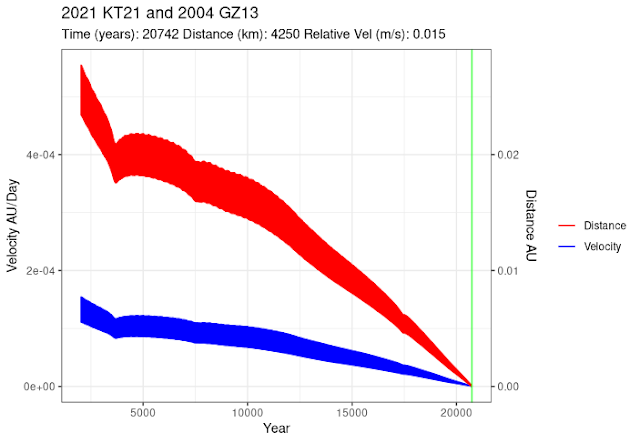This is a potentially interesting couple (future studies may confirm if these two asteroids separated from a common body or not).
Clones Generation
I generated 100 clones for each asteroid trying to achieve the same orbital parameters distribution as the real asteroids (data from JPL - Small-Body Database Lookup)
2007 TN89
| Clones | | Target |
|---|
| mean | sd | | mean | sd |
|---|
| q | 2.68037919449023 | 1.02422758252756e-07 | | 2.68037919030732 | 1.0278e-07 |
| e | 0.0332834075416157 | 3.72583687170622e-08 | | 0.0332834084098655 | 3.723e-08 |
| i | 4.87064454567147 | 4.91926754962451e-06 | | 4.87064467562245 | 4.9051e-06 |
| peri | 119.704478491351 | 9.26537293487407e-05 | | 119.70447923946 | 9.1341e-05 |
| node | 165.541938400386 | 5.00609236406486e-05 | | 165.541939646563 | 4.9617e-05 |
| tp | 2460623.98663213 | 0.000350292088224234 | | 2460623.98664169 | 0.00035377 |
2020 OJ94
| Clones | | Target |
|---|
| mean | sd | | mean | sd |
|---|
| q | 2.68031516329671 | 5.80931724850316e-07 | | 2.68031508062098 | 5.8247e-07 |
| e | 0.0332987005798029 | 2.12854522457715e-07 | | 0.0332987315205281 | 2.1173e-07 |
| i | 4.8708823913187 | 1.03347748674252e-05 | | 4.87088223032125 | 1.0457e-05 |
| peri | 119.702555842119 | 0.000210522154416148 | | 119.70257257331 | 0.00021113 |
| node | 165.541174514102 | 0.000118615308715787 | | 165.541191321507 | 0.00011803 |
| tp | 2460627.54541522 | 0.000804795345716826 | | 2460627.54557597 | 0.00080474 |
Simulation
The backward simulationwas done with Mercury 6 software taking into account all planets + Ceres + Pallas + Vesta:
)O+_06 Integration parameters (WARNING: Do not delete this line!!)
) Lines beginning with `)' are ignored.
)---------------------------------------------------------------------
) Important integration parameters:
)---------------------------------------------------------------------
algorithm (MVS, BS, BS2, RADAU, HYBRID etc) = BS
start time (days)= 2460125.5
stop time (days) = -1d8
output interval (days) = 100
timestep (days) = 0.05
accuracy parameter=1.d-12
Results
After the simulation finished, I compared all the 100x100=10^4 clone couples to determine the behaviour of the "best" couples sorting them by minimum relative velocity.
The top 10 couples behaved like this (relative distance in km, relative velocity in m/s):
Year relative_Distance relative_Velocity
1: -79283.756 3578.058 0.008
2: -167296.514 10004.868 0.008
3: -144257.301 7417.041 0.009
4: -101207.820 4225.343 0.009
5: -95159.236 4890.873 0.015
6: -133453.520 5479.847 0.017
7: -143202.385 4896.550 0.017
8: -111727.954 6362.393 0.020
9: -101200.975 5827.283 0.020
10: -225280.730 11845.825 0.020
The best couple (row 1) is this one:










